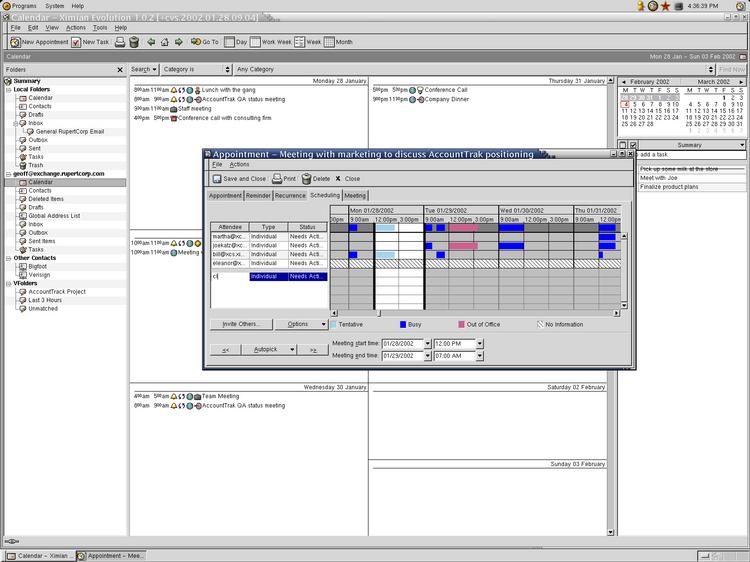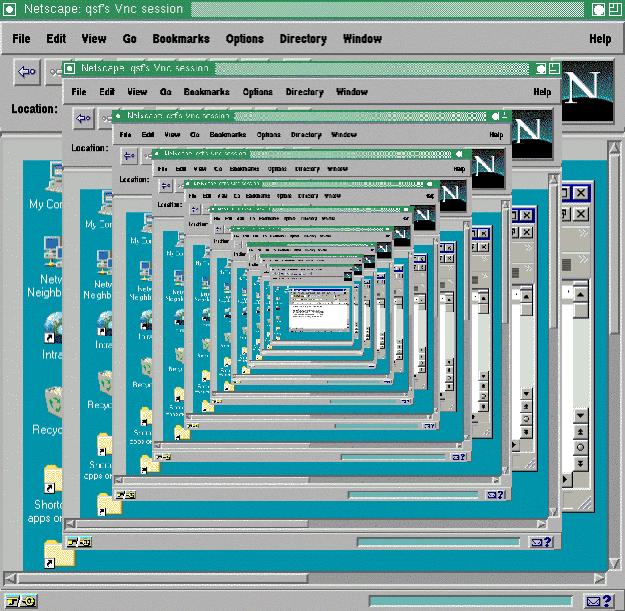Using Linux at Home: #2
Lots of people have told you that Linux is cheaper than Microsoft's Windows brand systems; this column
explores a different question: what are the risks and consequences
of using it at home?
In today's installment I'll look at the use of email and calendaring
on Linux at home for people who use one of Microsoft's
Outlook or Exchange products at work.
The good news is that there are lots of smart, easy choices. The bad news is that
all of them require some degree of co-operation from the Windows gurus at
work if you want to access your work email and schedule from home. If you don't,
there's no problem at all --Linux comes with all the mail, collaboration, and scheduling
facilities you're likely to need.
Connecting to your office email isn't technically difficult either, but it does
require the co-operation (although often
only through inaction) of your office network and server administrators because
they control the server accesses you'll need.
Among the many options three stand out
as particularly effective:
- You can compromise, trading off reductions in hassles against a reduction in the quality of service.
You can, for example, set up your office PC to
have yourself
notified of schedule changes via email and simply have it forward a copy of
your office email to your home address.
This is far from perfect or elegant, and means you'll be phoning the office
to schedule meetings but is dead simple, doesn't require active co-operation
from the office Windows gurus, and pretty much gives you the information you need
to work with.
- On the other hand, it kinda sucks from a convenience perspective. To get that,
and a few other benefits besides,
you could spend the $50 or so for the
Ximian evolution desktop. This gives you a fully integrated GNOME GUI with the
StarOffice productivity suite and a full Microsoft Exchange client - shown in use below.

With this stuff on your home box and a decent connection to your office server,
you might as well be in the office when it comes to scheduling and email, plus you
have such Linux advantages as the more consistent GUIs, full multi-tasking, and
greater reliability. The downside, other than the 50 bucks, is that the Windows
babysitters in your office can kill this by fire walling you off from the server.
Of course that shouldn't happen, but it often does because a lot of these guys don't really
understand where the security problems are and how to get you hooked up without compromising
it.
The right answer
is for them to establish a virtual private network, or VPN, in which your email and scheduling
information is encrypted as it travels across the internet. There are two main ways to do this:
- for a fixed link environment, for example between your home and your office, the right
answer is a router, like the linksys DSLrouter ($66 from your local Gateway store), that
has encryption and "tunneling" capabilities built in. That's a basically bullet proof, reasonably low cost,
approach that doesn't depend on PC software at the server end - you plug in both ends, turn them on, and the link works.
- for a roving remote user, for example someone connecting from hotel rooms while traveling, the better
approach is to process the user's email and scheduling information under a secure web server. Almost all
major browsers have encryption capabilities built in, so a remote user just fires up the browser and creates
a fully secure session by logging into the office https server.
This takes some office set-up and requires an an additional processing step on the server but has a fixed cost that
changes only with large jumps in the number of users. For one user the $5,000 or so required in the Windows server
environment is a lot; for 500, it's about the same as a can of Hub's roast peanuts.
Both, of course are cheaper and more reliable
than using something
like the CISCO VPN client for Windows 2000
but, sadly, the more common answer is for the wingots to insist on a Windows client and so
use your choice of Linux at
home as an excuse to wash their hands of the problem.
- Option three gives you a sneaky way of addressing that attitude by making it
a Windows networking problem, but it too requires
some degree of co-operation by the office gurus.
|
VNC connects a client, or viewer, with a server but doesn't really restrict what
those are, so people have done versions for devices including the Geo
communicator and Palm Pilot - just in case you want to run your Windows 2000
based Excel spreadsheet from your playphone.
In fact, if both ends support true multi-tasking
you can run both the server and
the client simultaneously on each of two machines to produce an apparently endless recursion of screen images
containing screen images - like holding a mirror before a mirror.
|

|
For this option you use either the freeware or shareware versions of
the
VNC product from AT&T's British research lab. This comes
as two parts: a server which you run on
the remote host (your office pc) and a viewer you run on your home machine. VNC connects
the mouse and keyboard on the remote host to their equivalents
on the
local, or viewer,
machine while mapping the remote monitor to a local window. As a result
it gives you your complete office desktop in a Linux
window at home.
Setting up either version for default configurations is utterly trivial - basically
click "install" and go. Getting it to work with secure shell and/or with a PC type firewall that does
network address translation requires some expertise but also illustrates the fundamental
open source idea that there's always another choice. In this case
the people behind tightvnc offer an upgraded shareware version (they ask for $10.00)
that makes this kind of thing much easier.
All three of these solutions come with some degree of risk even if that's nothing
more than the chance that someone will break in and steal the documents on your
home machine - along with the machine itself, of course.
The bottom line on using Linux at home to access office email and scheduling
running in an all Microsoft environment is that there are several very good
choices, but all them depend on some co-operation by the people who run your
office systems. Their "nyet!" may be pure reflex, but your response shouldn't
be.
Understand that the inevitable will happen, their network will be breached, some
documents or files will be compromised, and
"their" first response will be to blame you even if your entire home Linux
system is inherently more secure than their Microsoft client-server network.
The right answer here is the same as for any other predictable crisis: preparation and
planning. Before you start using office email and scheduling on Linux at home, get a paper
trail in place on what the risks and benefits are to your organization. If your boss sees the risks
as outweighing the benefits - simply don't do it. On the other hand,
discuss both the risks and the benefits with your boss, get that support visibly in place, and your decision
to use Linux at home won't mark you a maverick, it'll make you a leader.
next in series (Is it kid safe?)

